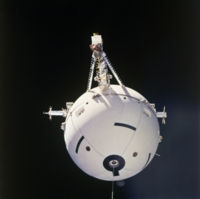STS-46
 | |
| Dane misji | |
| Indeks COSPAR | 1992-049A |
|---|---|
| Zaangażowani | |
| Oznaczenie kodowe | STS-46 |
| Pojazd | |
| Wahadłowiec | Atlantis |
| Załoga | |
 Siedzą od lewej: Andrew Allen, Loren Shriver. Stoją od lewej: Marsha Ivins, Claude Nicollier, Jeffrey Hoffman, Franklin Chang-Diaz, Franco Malerba | |
| Dowódca | Loren Shriver |
| Start | |
| Miejsce startu | Stany Zjednoczone, KSC, LC39-A |
| Początek misji | 31 lipca 1992 13:56:48 UTC |
| Orbita okołoziemska | |
| Apogeum | 437 km |
| Perygeum | 425 km |
| Okres orbitalny | 93,2 min |
| Inklinacja orbity | 28,45° |
| Lądowanie | |
| Miejsce lądowania | KSC, Pas startowy 33 |
| Lądowanie | 8 sierpnia 1992 13:11:50,3 UTC |
| Czas trwania misji | 7 dni, 23 godz, 15 min, 3 sek[1] |
| Przebyta odległość | 5 344 642 km[1] |
| Liczba okrążeń Ziemi | 221[1] |
| Program lotów wahadłowców | |
STS-46 (ang. Space Transportation System) – dwunasta misja wahadłowca kosmicznego Atlantis i czterdziesta dziewiąta programu lotów wahadłowców[2].
Załoga
- Loren Shriver (3)*, dowódca (CDR)
- Andrew Allen (1), pilot (PLT)
- Jeffrey "Jeff" Hoffman (3), specjalista misji 3 (MS3)
- Franklin Chang-Díaz (3), specjalista misji 4 (MS4)
- Claude Nicollier (1), specjalista misji 1 (MS1) (ESA, Szwajcaria)
- Marsha Ivins (2), specjalista misji 2 (MS2)
- Franco Malerba (1), specjalista ładunku 1 (PS) (Włochy)
- *(liczba w nawiasie oznacza liczbę lotów odbytych przez każdego z astronautów)
Parametry misji
- źródło[1]
- Masa:
- startowa orbitera: 116 133 kg
- lądującego orbitera: 94 711 kg
- ładunku: 12 965 kg
- Perygeum: 425 km
- Apogeum: 437 km
- Inklinacja: 28,45°
- Okres orbitalny: 93,2 min
Cel misji
Umieszczenie na orbicie samodzielnej platformy Eureca-1 (European Retrievable Carrier) oraz eksperyment z satelitą TSS-1 (Tether Satellite System), który został połączony z wahadłowcem za pomocą kabla o długości 22 km. Eksperyment z satelitą TSS-1 nie powiódł się – kabel zablokował się po rozwinięciu około 262 metrów i mimo licznych prób nie udało się go odblokować, dlatego zwinięto go i zabrano satelitę z powrotem na pokład wahadłowca[1][2].
Zobacz też
Przypisy
- ↑ a b c d e Mark Wade: STS-46 (ang.). W: Encyclopedia Astronautica [on-line]. [dostęp 2017-07-25].
- ↑ a b c Tomáš Přibyl: Dzień, w którym nie wróciła COLUMBIA. Bielsko-Biała: Wydawnictwo >DEBIT<, 2003, s. 167.
- ↑ Robert Godwin: Space Shuttle. Warszawa: Prószyński Media Sp. z o.o., 2011, s. 66. ISBN 978-83-7648-973-5.
Linki zewnętrzne
- podsumowanie misji STS-46 na stronie KSC (ang.)
- Mark Wade: STS-46 (ang.). W: Encyclopedia Astronautica [on-line]. [dostęp 2017-07-25].
- Spaceflight mission report: STS-46 (ang.). Space Facts. [dostęp 2014-06-04].
Media użyte na tej stronie
The flag of Navassa Island is simply the United States flag. It does not have a "local" flag or "unofficial" flag; it is an uninhabited island. The version with a profile view was based on Flags of the World and as a fictional design has no status warranting a place on any Wiki. It was made up by a random person with no connection to the island, it has never flown on the island, and it has never received any sort of recognition or validation by any authority. The person quoted on that page has no authority to bestow a flag, "unofficial" or otherwise, on the island.
STS-46 Mission Insignia
This Space Shuttle Orbiter Atlantis (STS-46) onboard photo is a close-up view of the Tethered Satellite System (TSS-1) in orbit above the Shuttle. A cooperative development effort by the Italian Space Agency (ASI) and NASA, the Tethered Satellite System (TSS) made capable the deployment and retrieval of a satellite which is attached by a wire tether from distances up to 100 km from the Orbiter. These free-flying satellites are used as observation platforms outside of the Orbiter.
The STS-46 crew portrait includes 7 crew members. Seated in front (left to right) are Andrew M. Allen, pilot; and Loren J. Shriver, commander. Standing (left to right) are Marsha S. Ivins, mission specialist 4; Claude Nicollier, mission specialist 3; Jeffrey A. Hoffman, mission specialist 1; Franklin R. Chang-Diaz, mission specialist 2; and Franco Malerba, payload specialist 1. Launched aboard the Space Shuttle Atlantis on July 31, 1992 at 9:56:48 am (EDT), the mission's primary objectives included the deployment of the European Space Agency's European Retrievable Carrier (EURECA) and operation of the joint NASA/Italian Space Agency Tethered Satellite System (TSS).




